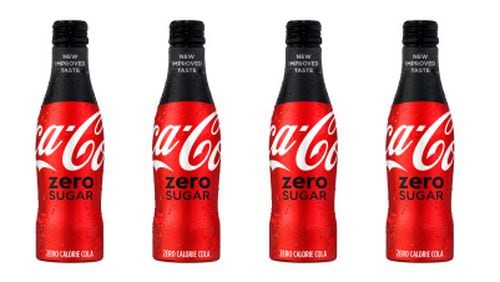A repeat of the “New Coke” disaster, this probably isn’t.
Coca-Cola announced last week that it is rolling out a new version of its popular Coke Zero brand with a new formula, look, and name. Coca-Cola Zero Sugar is supposed to taste much like regular Coke and give health-conscious people a better-tasting sugar-free alternative.
But Coca-Cola kicked an ant hill with the announcement. For a few days, angry customers swarmed online with stinging comments asking the Atlanta soft drink giant why it was messing with “their” Coke Zero.
“I finally find a diet drink I love and now you are changing it!!!! I well remember “New Coke” and how bad it was. Thanks so much. Will try it, but not expecting much,” groused one customer last week on Coke’s Facebook page. Hers was among several hundred comments, most of them negative.
Atlanta-based Coca-Cola’s social media team responded with dozens of perky posts answering customers’ concerns.
“Hi Kyle!,” the Coke team answered one customer worried about the new drink’s taste. “We’ve used our advanced in-house innovation capabilities to make the great taste of Coke Zero even better and a lot like a Coke. It’s refreshing and our best-tasting zero-sugar Coca-Cola yet!”
Another customer’s grumbling response: “Is that the advanced in-house innovation capabilities that you used for New Coke? Will I get to see Classic Coke Zero by New Year’s?”
The running joke, of course, refers to Coca-Cola’s infamous launch of New Coke in the 1980s to replace its flagship beverage. Customers revolted. Coke eventually brought back the old version, initially called “Classic” Coke.
‘It freaks people out’
Brand and industry experts don’t think Coca-Cola is about to repeat that blow-up. But some do say the hoopla was unnecessarily upsetting to its Coke Zero fans and may even be confusing customers — the opposite of what Coke intended.
“I don’t understand why they didn’t just reformulate the product and keep it Coke Zero,” said Laura Ries, president of Atlanta brand consulting firm Ries & Ries. “They make such a hoopla out of it, it freaks people out,” she said. Besides, she added, the new name is a “mouthful.”
For now, it appears that Facebook and other social media have allowed Coke Zero fans to quickly vent their anger and move on — at least until the new drink starts hitting stores this week.
Google Trend statistics showed that the volume of internet searches for “Coca-Cola Zero Sugar” shot up on the day of Coca-Cola’s announcement, but within two days, traffic had dropped back to near, well, zero.
Coke spokesman Scott Williamson said the online blowback isn’t worrisome.
“We conducted extensive consumer testing and research in the U.S. for over a year,” he said. “We’re confident Coca-Cola Zero Sugar recipe delivers a great taste that Coke Zero fans will love when they try it.”
So why is the company kicking Coke Zero, first launched in 2005?
According to Coke, the new version is a better-tasting formula that might revive flagging diet-drink sales. It has revved up stalled sales by over 10 percent in more than 25 countries where it has replaced the older Coke Zero version, the company says.
Slipping sales
That's a big accomplishment. Diet Coke is the biggest diet soda brand in the U.S., but its sales have been slipping for years. It dropped from almost $3.6 billion in 2011 to $2.8 billion last year, according to Euromonitor, a market research firm. Coke Zero has grown to the nation's third largest diet brand, but its sales dropped last year to a little over $1 billion.
Coca-Cola sees Coke Zero Sugar as something of a beverage makers’ Holy Grail: a replacement that tastes more like its traditional sodas, but without the sugar that has been blamed for rising rates of diabetes and obesity.
The name change is to drive home that point, according to Coke.
Coca-Cola also is giving the product’s bottles and cans a new, mostly red paint job — instead of Coke Zero’s mostly black color scheme — as part of a slow-motion effort to harmonize all of its colas behind its traditional trademark, “Coca-Cola” on a red disk. Zero Sugar is the first product to get the new look in the U.S.
“It’s part of what we call the One Brand strategy,” said James Quincey, named Coke’s new CEO in May. It “will actually help people stay in the Coca-Cola franchise,” he said in a conference call with investors.
Just over a year ago, Coca-Cola first rolled out the Zero Sugar brand in Great Britain after spending years and 30 million pounds ($39 million at current exchange rates) reformulating and developing the product, according to Coca-Cola’s British web site.
The company said its 10 million pound ($13 million) marketing push was aimed at encouraging traditional Coke drinkers to try its no-sugar offering. It opened temporary tasting lounges in London.
Williamson, the Coke spokesman, said the company will use a similar approach in the U.S. The company will give customers Zero Coke samples at college football games starting with Labor Day weekend.
Identical ingredients
Starting in August, Coke also plans to stock stores with 8.5-oz. bottles of Zero Sugar for less than $1 for a limited time, he said.
Ries, the marketing consultant, suspects people won’t notice much of a difference in taste.
Indeed, the listed ingredients are identical to those in Coke Zero, indicating that the new recipe could be more of a tweak than a substantial reformulation.
But Coke could still be headed for a wrong turn, she added.
“People don’t like change,” she said, and Coke is changing the recipe, packaging and name.
“That’s going to cause confusion. There’s nothing people hate more than getting the wrong thing” at the store, she said, noting that the new red packaging looks a lot like traditional Coke.
Moreover, she said, Coca-Cola could risk damage to one of its most successful brands, she said.
When Coke Zero was launched in 2005, “it was a revolutionary product,” said Ries. It was a diet drink that wasn’t branded with the unpopular diet label. Coca-Cola was able to get men to embrace it by pitching it at sports events.
“Now they’re kind of tossing it away,” she said.
THINNING SALES
The top five U.S. diet cola brands have mostly been in decline in recent years.
Brand, change from 2011-2016
Diet Coke, -20%
Diet Pepsi, -23%
Coca-Cola Zero, +7%*
Caffeine Free Diet Coke, -36%
Cherry Coke Zero, -12%
* Coke Zero sales have declined the last four years, by almost 3 percent.
Source: Euromonitor
About the Author






